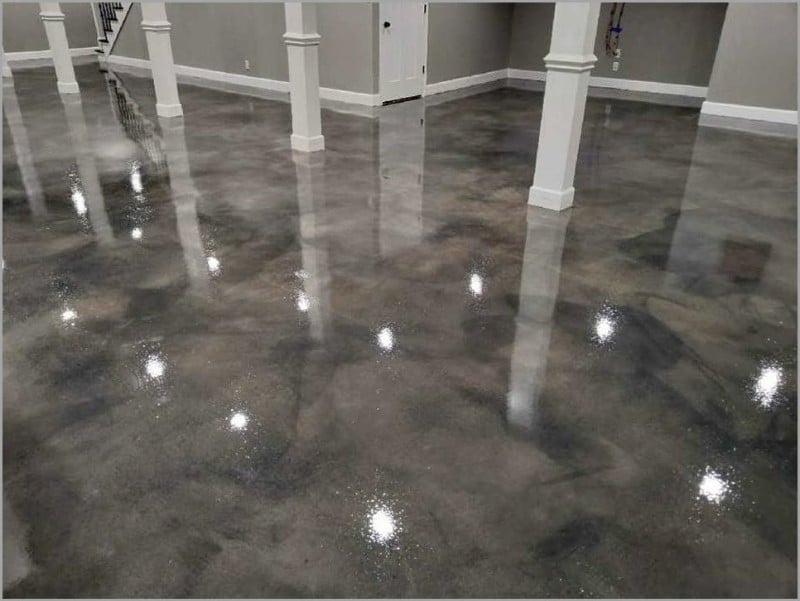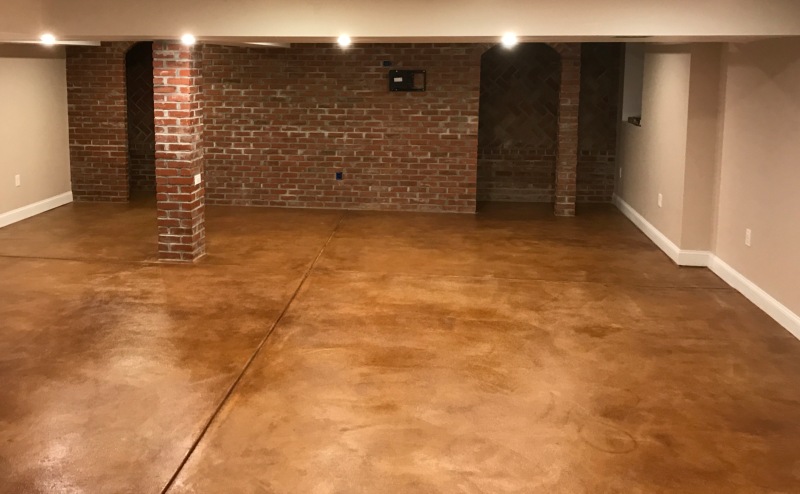Understanding the Various Kinds Of Stained Concrete for Your Following Task
Stained concrete offers numerous choices that satisfy various visual and useful needs. Each kind presents distinct qualities that influence the final look and longevity of the surface area. Understanding these differences is crucial for anybody intending a project. From abundant, chain reactions of acid-based stains to the dynamic harmony of strong shade stains, the choices can greatly affect the end result. What elements should one consider when selecting the optimal discolor for their particular needs?
Summary of Stained Concrete
Stained concrete functions as a functional floor covering option that can improve the aesthetic appeal of various spaces. This strategy includes applying a tinting agent to the surface area of existing concrete, permitting for a wide range of layout opportunities. Stained concrete is preferred in both domestic and business atmospheres, using a long lasting and low-maintenance remedy that can imitate the appearance of natural materials like stone or tile.
The staining procedure can be performed utilizing water-based or solvent-based items, each supplying distinct aesthetic impacts. The last appearance is affected by variables such as the initial concrete surface area, the type of discolor used, and the application approach. Stained concrete not just enhances exterior and interiors yet likewise advertises sustainability by renewing existing concrete structures. Because of this, it has actually gained traction among property owners and designers seeking both capability and design in their floor covering choices.
Acid-Based Stains: Qualities and Advantages

One-of-a-kind Shade Variants
Concrete surface areas can transform substantially with the application of acid-based stains, which supply an abundant palette of unique shade variants. These stains penetrate the concrete, reacting chemically to create dynamic planet tones that vary from deep browns and reds to soft eco-friendlies and blues. The resulting colors are typically variegated, producing a natural, marble-like appearance that enhances the concrete's character. Each application yields distinctive results due to variants in the concrete's make-up and the discoloration strategy made use of, making every job special. In addition, acid-based stains can be split or integrated with various other methods to develop tailored layouts, enabling individual expression. This flexibility makes acid-based stains a prominent choice for both household and industrial applications.
Chemical Responses Clarified
While numerous factors add to the effectiveness of acid-based stains, the underlying chain reaction play a crucial role in their one-of-a-kind characteristics and advantages. These stains largely contain water, acid, and metal salts. When related to concrete, the acid responds with the calcium hydroxide in the cement, creating a chemical transformation that results in long-term shade modifications. The metallic salts pass through the surface area and bond with the concrete, permitting a variety of tones and tones. This response not just boosts aesthetic appeal however likewise provides sturdiness, making the color resistant to fading and wear. Furthermore, acid-based stains can create a variegated surface that resembles natural rock, further improving their appeal for ornamental concrete applications.
Surface Area Prep Work Significance
Accomplishing ideal outcomes with acid-based stains pivots on comprehensive surface prep work. This crucial step warranties that the concrete surface area is tidy, devoid of impurities, and effectively profiled for suitable discolor absorption. Any kind of existing sealers, dirt, or oils can hinder the chain reaction that produces the wanted shade and coating, causing unequal or uneven outcomes.
Prior to using the discolor, the concrete should be mechanically cleaned up or pressure washed, followed by a comprehensive inspection for fractures or imperfections that might call for fixing. Additionally, confirming the surface area is sufficiently dried will improve discolor adherence. By prioritizing these primary measures, the longevity and vibrancy of acid-based stains can be greatly enhanced, leading to a more aesthetically pleasing and durable coating.
Water-Based Stains: Attributes and Benefits

Water-based stains permeate the concrete, providing a much more clear coating that highlights the natural appearance and variants of the surface underneath. They are available in a vast range of shades, enabling innovative flexibility in layout. Additionally, water-based stains are easier to cleanse up, needing just water and soap, which simplifies the application process.
Their quick drying time improves effectiveness, making them a useful selection for both DIY navigate to this site enthusiasts and experts. Overall, water-based stains give an attractive combination of aesthetic convenience and easy to use properties, making them a popular alternative for concrete improvement projects.
Solid Color Stains: Dynamic Options for a Vibrant Look
Solid shade stains supply a reliable service for those seeking to produce a vibrant and vibrant aesthetic on concrete surfaces. These stains give a consistent pigmentation that can substantially improve the aesthetic appeal of floorings, outdoor patios, and driveways. Available in a large range of tones, strong shade stains permit innovative expression, accommodating various layout choices.
One of the key advantages of solid shade stains is their capability to hide imperfections, offering a fresh and refined want to maturing concrete - Stained Concrete Austin. Additionally, their formulation normally consists of UV-resistant buildings, making certain long life and shade retention even in harsh weather conditions
Application is simple, calling for marginal preparation of the concrete surface area. As soon as applied, solid shade stains can be secured for added defense and sheen, more raising their visual top quality. With their vivid alternatives, strong shade stains are an exceptional selection for those intending for an impactful and cohesive design.
Semi-Transparent Stains: Accomplishing Deepness and Dimension
Semi-transparent stains provide a special strategy to boosting concrete surface areas by offering depth and measurement with numerous color choices. Understanding the application techniques is necessary for achieving the wanted effect, while correct maintenance techniques guarantee long life. This section will discover these key elements to make best use of the advantages of semi-transparent discoloration.
Shade Options Available
A variety of color alternatives exists for semi-transparent stains, allowing property owners and developers to boost the all-natural charm of concrete surfaces. These stains are available in a selection of colors, from natural tones like browns and terracottas to dynamic shades such as blues and environment-friendlies. The semi-transparent nature of these stains allows the underlying concrete to show through, producing a distinct depth and dimension that can complement various design looks. In addition, combining different shades can create custom tones, allowing a customized search for each job. This flexibility makes semi-transparent stains a popular selection for both exterior and interior applications, as they can balance with surrounding elements while adding aesthetic rate of interest to ordinary concrete.
Application Strategies Explained
To accomplish the wanted deepness and measurement with semi-transparent stains, appropriate application strategies are important. Initially, surface preparation is important; the concrete needs to be clean and devoid of any kind of contaminants. This commonly entails power washing and repairing any splits. Next off, choosing the appropriate applicator, such as a sprayer, roller, or brush, can influence the last look. Sprayers permit for a more even application, while rollers can aid attain texture. It is essential to apply the discolor in thin, also layers, allowing each layer to completely dry prior to adding an additional. Adjusting the application technique, such as differing pressure or utilizing various tools, can develop distinct effects. Sealing the stained surface area enhances the vibrancy of the colors while offering defense.
Upkeep Ideal Practices
Routine maintenance is crucial for preserving the beauty and integrity of surfaces treated with semi-transparent stains. To preserve these surfaces, routine cleansing is important. Utilizing a pH-neutral cleaner and a soft-bristle mop will help remove dirt and debris without harming the stain. It is suggested to stay clear of severe chemicals, as they can break down the tarnish's appearance. Furthermore, routine resealing each to 3 years can shield against wear and fading. This process involves cleaning up the surface area thoroughly and applying a compatible sealer developed for stained concrete. Home owners need to also keep an eye on for any type of signs of discoloration or damage and address these problems without delay to guarantee resilient vibrancy and durability. Complying with these finest methods will certainly enhance the total life expectancy of semi-transparent stained surface areas.
Effects and Methods: Customizing Your Stained Concrete
Customizing stained concrete involves a range of techniques that improve both aesthetics and functionality. Amongst these techniques, layering different tarnish shades can create deepness and complexity, allowing for special aesthetic effects. Strategies such as acid discoloration offer a variegated look, while water-based stains supply a much more uniform look.
Furthermore, incorporating decorative patterns, such as stenciling or engraving, can better personalize the surface, adding elaborate designs that satisfy individual tastes. Texturing the concrete, whether with stamping or broom finishes, presents tactile aspects that not only enhance hold but likewise enhance aesthetic rate of interest.
Applying sealers can amplify the shade vibrancy and offer security against wear. Customization methods expand beyond simple shade; they can transform a conventional concrete piece right into a stunning centerpiece, making it ideal for both domestic and commercial rooms. Through mindful option of impacts and methods, stained concrete discover this info here can attain an absolutely tailored look.
Maintenance and Long Life of Stained Surfaces
Although stained concrete surface areas are recognized for their toughness and aesthetic appeal, maintaining their stability is essential for making sure long life. Routine cleansing is vital; sweeping and mopping with a pH-neutral cleaner aids prevent dust accumulation and discoloration. In addition, using a sealer every few years can safeguard the surface area from discover this info here dampness, chemicals, and UV damages, thus improving its life-span.
It is also crucial to attend to any splits or chips quickly. Little repairs can minimize additional wear and tear, protecting the visual and structural high quality of the surface area. For exterior stained concrete, seasonal maintenance, such as getting rid of snow and ice, is required to stop surface damage from freeze-thaw cycles.
Often Asked Concerns
Can I Discolor Existing Concrete Surfaces or Only Brand-new Ones?
The concern of whether existing concrete surface areas can be stained emerges often. It is certainly possible to discolor both new and old concrete, gave the surface is properly ready and complimentary of pollutants for suitable adhesion.
For how long Does the Discoloration Refine Commonly Take?
The discoloration process normally takes one to 3 days, depending on elements such as surface area preparation, sort of tarnish, and climate condition. Stained Concrete Floors Austin Texas. Treating time might prolong beyond preliminary application, influencing the general period considerably
Is Stained Concrete Safe for Outdoor Use?
Stained concrete is usually secure for outside usage, provided it is appropriately sealed. This sealing safeguards against moisture and UV damage, making certain longevity and safety, while also improving the aesthetic allure of outside spaces.
Can I Apply Multiple Spot Layers for Different Effects?
Applying multiple stain layers can accomplish different results on stained concrete. Nevertheless, it is necessary to ensure compatibility between stains and permit appropriate drying time between applications to prevent unexpected reactions or discoloration.
Exist Any Kind Of Color Limitations for Stained Concrete?
Shade constraints for stained concrete mostly rely on the type of discolor utilized, with water-based stains offering a more comprehensive scheme contrasted to acid-based stains. Stained Concrete Floors Austin Texas. Attaining vibrant colors might require cautious selection and application methods.